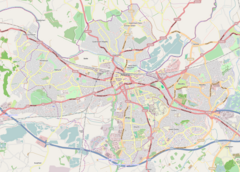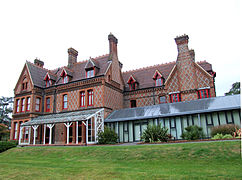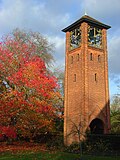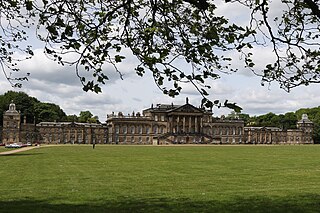
Wentworth Woodhouse is a Grade I listed country house in the village of Wentworth, in the Metropolitan Borough of Rotherham in South Yorkshire, England. It is currently owned by the Wentworth Woodhouse Preservation Trust. The building has more than 300 rooms, although the precise number is unclear, with 250,000 square feet (23,000 m2) of floorspace. It covers an area of more than 2.5 acres (1.0 ha), and is surrounded by a 180-acre (73 ha) park, and an estate of 15,000 acres (6,100 ha).

Alfred Waterhouse was an English architect, particularly associated with the Victorian Gothic Revival architecture, although he designed using other architectural styles as well. He is perhaps best known for his designs for Manchester Town Hall and the Natural History Museum in London, although he also built a wide variety of other buildings throughout the country. Besides his most famous public buildings he designed other town halls, the Manchester Assize buildings—bombed in World War II—and the adjacent Strangeways Prison. He also designed several hospitals, the most architecturally interesting being the Royal Infirmary Liverpool and University College Hospital London. He was particularly active in designing buildings for universities, including both Oxford and Cambridge but also what became Liverpool, Manchester and Leeds universities. He designed many country houses, the most important being Eaton Hall in Cheshire, largely demolished in 1961-63. He designed several bank buildings and offices for insurance companies, most notably the Prudential Assurance Company. Although not a major church designer he produced several notable churches and chapels. He was both a member of The Royal Institute of British Architects, of which he served a term as President, and a Royal Academician, acting as Treasurer for the Royal Academy.

Rufus Daniel Isaacs, 1st Marquess of Reading, was a British Liberal politician and judge, who served as Lord Chief Justice of England, Viceroy of India, and Foreign Secretary, the last Liberal to hold that post. The second practising Jew to be a member of the British cabinet, Isaacs was the first Jew to be Lord Chief Justice, and the first, and as yet, only British Jew to be raised to a marquessate.
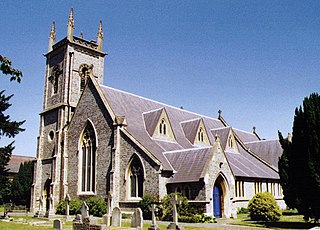
Earley is a town and civil parish in the Borough of Wokingham, Berkshire, England. Along with the neighbouring town of Woodley, the Office for National Statistics places Earley within the Reading/Wokingham Urban Area; for the purposes of local government it falls within the Borough of Wokingham, outside the area of Reading Borough Council. Its name is sometimes spelt Erleigh or Erlegh and consists of a number of smaller areas, including Maiden Erlegh and Lower Earley, and lies some 3 miles (5 km) south and east of the centre of Reading, and some 4 miles (6 km) northwest of Wokingham. It had a population of 32,036 at the 2011 Census.

Eaton Hall is the country house of the Duke of Westminster. It is 1 mile (2 km) south of the village of Eccleston, in Cheshire, England. The house is surrounded by its own formal gardens, parkland, farmland and woodland. The estate covers about 10,872 acres (4,400 ha).

The Darwin D. Martin House Complex is a historic house museum in Buffalo, New York. The property's buildings were designed by renowned architect Frank Lloyd Wright and built between 1903 and 1905. The house is considered to be one of the most important projects from Wright's Prairie School era.

Hinderton Hall is a country house to the northeast of Neston, Cheshire, England.

Whiteknights Park, or the Whiteknights Campus of the University of Reading, is the principal campus of that university. The park covers the area of the manor of Earley Whiteknights, also known as Earley St Nicholas and Earley Regis.

The Victoria Building of the University of Liverpool, is on the corner of Brownlow Hill and Ashton Street, Liverpool, Merseyside, England. It is recorded in the National Heritage List for England as a designated Grade II listed building. It was designed by Alfred Waterhouse and completed in 1892. It was the first purpose-built building for what was to become the University of Liverpool, with accommodation for administration, teaching, common rooms and a library. The building was the inspiration for the term "red brick university" which was coined by Professor Edgar Allison Peers. In 2008 it was converted into the Victoria Gallery & Museum.

Shibden Hall is a Grade II* listed historic house located in a public park at Shibden, West Yorkshire, England. The building has been extensively modified from its original design by generations of residents, although its Tudor half-timbered frontage remains its most recognisable feature.

Thornton Hough is a village on the Wirral Peninsula, in Merseyside, England, of pre-Conquest origins. The village grew during the ownership of Joseph Hirst into a small model village and was later acquired by William Lever, founder of Lever Brothers, the predecessor of Unilever. Thornton Hough is roughly 10 miles (16 km) from Liverpool and 12 miles (19 km) from Chester. Administratively, it is part of the Clatterbridge Ward of the Metropolitan Borough of Wirral and is in the parliamentary constituency of Wirral South.
Paul Waterhouse was a British architect.

Edwin Waterhouse was an English accountant. He is best known for having co-founded, with Samuel Lowell Price and William Hopkins Holyland, the accountancy practice of Price Waterhouse that now forms part of PricewaterhouseCoopers.

Reading Town Hall is the town hall of Reading, Berkshire, England. The town hall was built in several phases between 1786 and 1897, although the principal facade was designed by Alfred Waterhouse in 1875. Situated close to the site of Reading Abbey, it is adjoined to the north by the Hospitium of St John and to the south by St Laurence's Church.

The former Manchester Law Library is a Grade II* listed building in the Venetian Gothic style at 14 Kennedy Street, Manchester. The building is notable as having housed the oldest provincial law library in England. Its architect, Thomas Hartas, is little known, and the former Law Library appears to be his only documented building. In 2015 the Manchester Incorporated Law Library Society sold the premises, and moved to new offices on Booth Street.

The West Memorial Hall, or West Memorial Institute, is a Victorian Grade II listed building at 7-9 Gosbrook Road, Caversham, Berkshire, designed by Alfred Waterhouse. The Hall is a former Baptist Free Church that has now been converted to apartments.
Swanborough Manor is a listed English manor dating back to the 12th century in Iford, East Sussex.

Tower House is a former private house in the Withdean area of the English coastal city of Brighton and Hove. Built in 1902 for a former jeweller to King Edward VII, it remained in private ownership until it was converted into flats and a daycare centre in 1988. It is one of the few large houses and villas to survive in the high-class Withdean area—many were demolished in favour of blocks of flats after World War II—and it has been described as "Brighton's finest example of a grand Edwardian house". English Heritage has listed the building at Grade II for its architectural and historical importance.

Oakly Park, Bromfield, Shropshire, England is a country house dating from the 18th century. In the early 19th century, the house was restored and extended by Charles Robert Cockerell, Surveyor to the Bank of England for his friend Robert Henry Clive. The private home of the Earls of Plymouth, Oakly Park is a Grade II* listed building.

